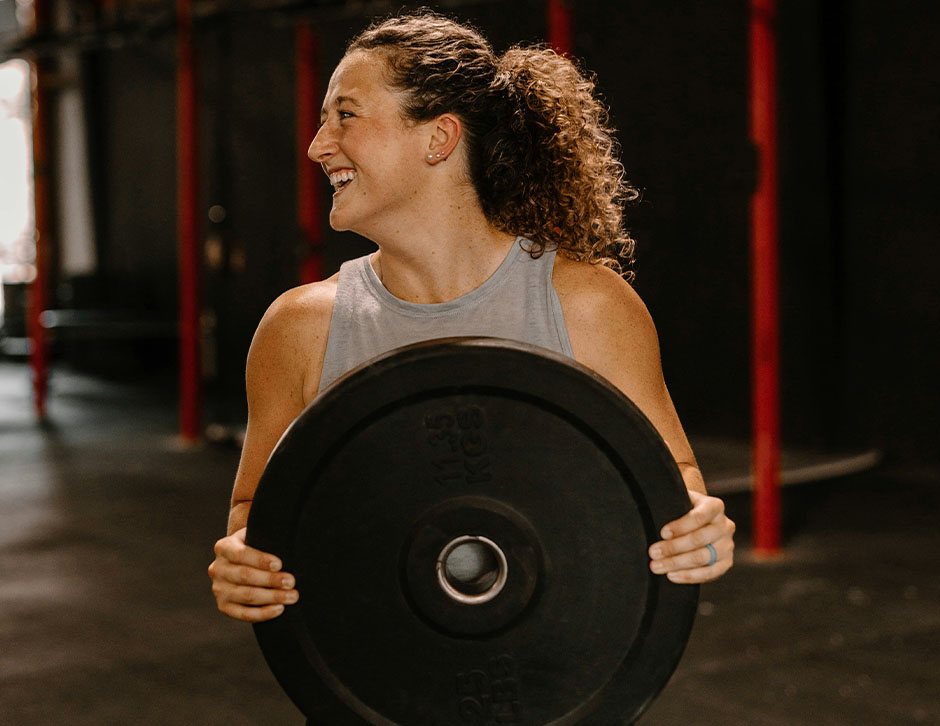
Here’s what we’ll cover in this blog post:
- The importance of strength training for women
- Debunking common myths about strength training
- How to get started in the weight room
Let’s be honest: for decades, the weight room hasn’t exactly felt like the most welcoming place for women. While the cardio section hums with treadmills and ellipticals, the squat racks and weight sections often hum with men.
For many women, stepping into that space can feel unfamiliar—even a little intimidating. They walk in and see mostly men: earbuds in, chalk on their hands, lost in their own world. For some, it can be hard not to feel like an outsider, even when no one seems to be looking.
But that’s changing.
More and more women aren’t just stepping into weight rooms; they’re owning them. They’re reclaiming space that was never truly off-limits, but often made to feel that way. The truth is, strength training is one of the most powerful investments a woman can make in her health, confidence, and long-term well-being.
Why Women Actually Benefit More from Strength Training
The science is loud and clear: strength training is especially powerful for women. In a 2024 study from the NIH, researchers found that women gained greater longevity and heart-health benefits from both cardio and resistance training than men did. Women not only experienced greater benefits than men, but they achieved them in significantly less time. Just 1-2 strength sessions and 140 minutes of aerobic training every week had a measurable effect on reducing risk of cardiovascular disease and all-cause mortality.
Other benefits that skew heavily in favor of women include:
- Improved bone density and reduced risk of osteoporosis
- Better blood sugar regulation and insulin sensitivity
- Enhanced cognitive function, especially post-menopause
- Reduced risk of injury and chronic pain
- Stronger posture, balance, and functional independence as we age
Strength training has a massive impact on mood and mental well-being. Mental health is always important, but it becomes increasingly relevant through hormonal shifts in our 30s, 40s, and beyond.
So if women stand to make serious gains with weightlifting, why do we feel like we can’t easily step into that world?
Diving Into Common Myths
Myth #1: “If I lift weights, I’ll get bulky.”
This is one of the most persistent (and inaccurate) myths around women and strength training. The truth? Women experience less skeletal muscle hypertrophy than men and do not have the hormonal profile needed to “bulk up” like men do. Building large muscle mass takes a level of intention, consistency, and nutrition most women simply aren’t pursuing.
Instead, strength training leads to a lean, toned physique, enhanced metabolism, and improved overall body composition. Women get stronger, not bigger.
Myth #2: “Cardio is better for weight loss.”
Cardio burns calories during the workout. Strength training burns calories during and after thanks to something called excess post-exercise oxygen consumption (EPOC). Plus, muscle mass increases resting metabolic rate, meaning the body burns more calories just by existing.
So if fat loss is the goal, weights should be in the corner. And even if it’s not the primary goal? Muscle supports long-term health in ways cardio alone simply doesn’t.
Myth #3: “The weight room isn’t for women.”
This one isn’t always said out loud, but it’s deeply felt. Whether it’s the lack of representation, the awkward glances, or the subtle territorial energy of those in the gym, many women are led to believe they don’t “belong” in the free weights section.
But the weight room is for everyone. Women have every right to take up space, experiment, and get strong without apology. More women in the weight room doesn’t just benefit individual health—it helps reshape a culture.
Getting Started in the Weight Room
Walking into the weight room for the first time can be nerve-wracking. But it doesn’t have to be. Here’s how to get started in a way that feels sustainable and empowering:
- Start simple
No elaborate plan or hours of time required. Just two days a week of strength training can make a meaningful difference. Focus on compound movements that work multiple muscle groups at once—squats, deadlifts, push-ups, rows, and more. - Don’t be afraid to ask for help
Whether it’s a personal trainer, a group class, or even a knowledgeable friend, learning good form builds confidence and reduces injury risk. - Alternate between bodyweight, machines, and free weights
Machines can be a great starting point for learning form and getting comfortable. As strength builds, transitioning to dumbbells or barbells can help diversify workouts.
To put it simply: don’t let gym culture define the limits. Create a playlist. Follow an online guided workout. Wear what feels powerful. Even if the first few sessions feel uncomfortable, stay consistent!
The Culture Is Shifting and You’re a Part of It
There’s something powerful happening. More women are walking into weight rooms, lifting heavy, and redefining what strength means—not just physically, but emotionally, socially, and generationally. Every rep is a quiet rebellion against the idea that strength belongs to someone else.
And here’s the best part: women don’t just benefit from strength training. They thrive from it. Strength training for women supports everything from longer lifespans and stronger hearts to improved mood and increased bone density.
So whether it’s picking up that first dumbbell or simply considering it, one thing is clear:
The weight room is for women, too. There’s never been a better time to step into strength.
Note: The above statements have not been evaluated by the Food and Drug Administration. This product is not intended to diagnose, treat, cure, or prevent any disease.
